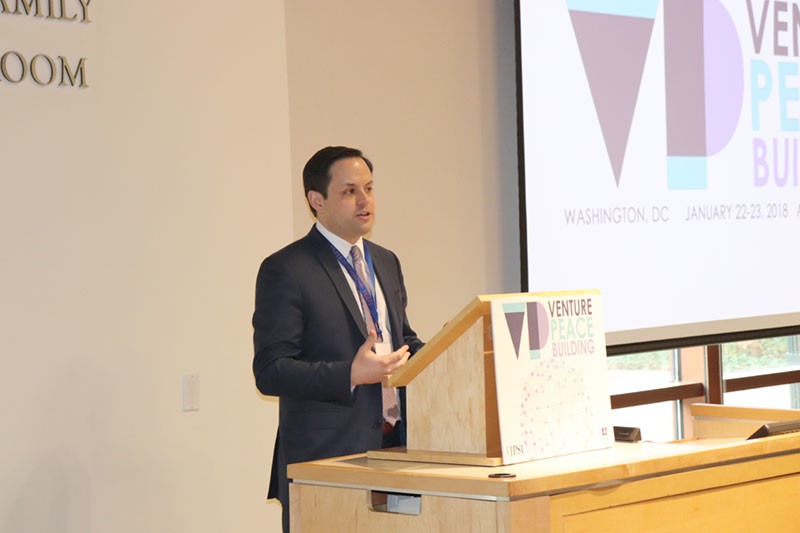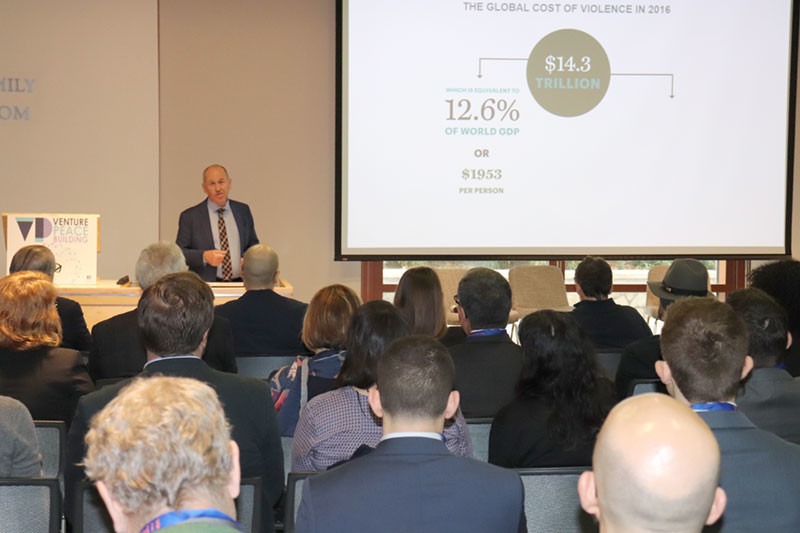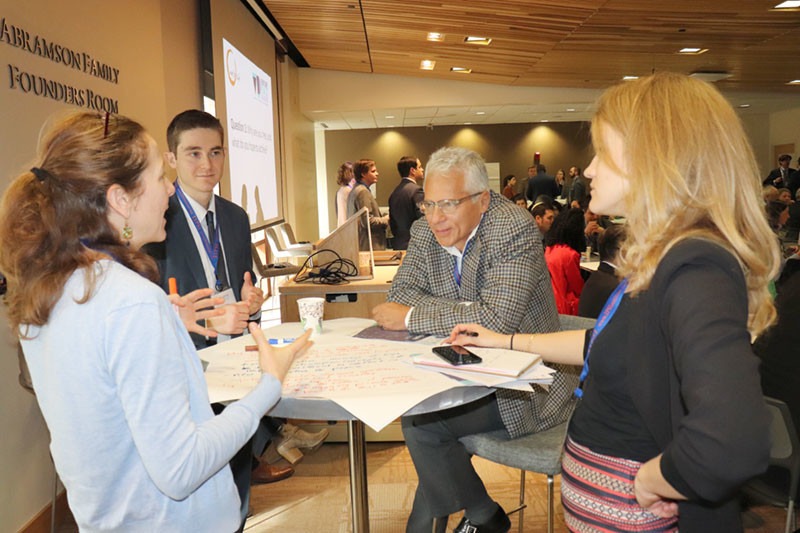Peacebuilders, development practitioners and social entrepreneurs made a compelling case to investors during a two-day Venture Peacebuilding Symposium in Washington, D.C.
Their proposition? Investments in smart, scalable social business solutions to stabilize fragile communities and solve complex development challenges can reap high dividends and do social good.
“The reality is that the peacebuilding field has not yet provided the business community with the factual basis to invest in peace,” said Cameron M. Chisholm, Vice President of Creative Learning and Founder of the International Peace & Security Institute, kicking off event on Jan. 23.

“Peace has had a branding problem,” he added. “The case for peace has been a moral argument and now our challenge is to make it a factual one. A financial one.”
Convened by the International Peace & Security Institute, the event brought together nearly 150 leaders in impact investing, social entrepreneurship and peacebuilding to lay the foundations for the practice of venture peacebuilding, strategically and innovatively using capital to fund business solutions that promote peace.
The symposium was also sponsored by Creative Associates International, as well as American University, Creative Learning, Euromonitor International, Peace and Collaborative Development Network, Strategic Good, Alliance for Peacebuilding, Peace Direct, Impact Hub, PeaceTech Lab, C5 Accelerate, SAP NS2, SkapaTech and Konesens Development.
High returns on investment
Speakers noted that the financial case for peace investments is borne out by the date.
The Global Peace Index, which uses 23 indicators to assess levels of peace for 99.7 percent of the world’s population, places the possible rate of return at 1:16. For every $1 put into peacebuilding, society gains $16 due to gains in indicators from income per capita to less corruption that are correlated with positive peace. The Index defines positive peace as the attitudes, institutions and structures that create and sustain peaceful societies, rather than simply the absence of violent conflict.
These are also gains for an investor as positive peace supports a better business environment in which to grow the social business they have supported.

“Countries that are improving in positive peace have on average a 2 percent per annum growth rate compared to countries falling in positive peace,” added Steve Killelea, Founder and Executive Chairman of the Institute for Economics and Peace, which publishes the annual index.
The Global Peace Index also reports that the average cost of conflict for the 10 most violent countries last year was equivalent to 37 per cent of their GDP. And while war cost the world’s economies $1.04 trillion in 2017, investments in peace only totaled $10 billion.
To date, peacebuilders have largely not tapped into impact investment capital, which totaled some $114 billion globally in 2017, according to the Annual Impact Investor Survey.
The Venture Peacebuilding Symposium is the start of a new way of doing business and doing good, said Chisholm.
He added that as social goods such as open governance, rule of law, respect for human rights and a more equal distribution of resources increase, so too does the level of peace in a society, making conflict, and its costs, less likely.
Seeking systems change
But peace is a complex phenomenon that requires the transformation of systems rather than isolated projects or programs, speakers noted. This means targeting human development indicators in addition to breaking down more complex barriers to peace, including power imbalances, corruption, gender inequality and poor governance structures, among others.
“When we seek positive peace then we are looking for driving systems change,” said Shamil Idriss, President of Search for Common Ground, adding that to do this successfully means changing norms within communities about how people engage with each other.
Though systems change is no easy task, the peacebuilding and social entrepreneurship experts suggested a few key ingredients to increase the probability of success and therefore higher rates return on investments in peace.
1) Systemic change requires local leadership and ownership to take root.
Ayan Kishore, Director of the Development Lab at Creative Associates International, which supports innovative technological approaches to address development and peacebuilding challenges, urged participants to consider funding local actors who know the challenges facing their societies and can drive unique solutions to them.
“This means leveraging the local ecosystem of technology and civil society to basically provide a funding mechanism for peace entrepreneurship,” he said.
Making a special call to the development practitioners, he added. “I challenge you to think about taking our traditional work we have been doing and reframe it as to how it would not only be useful to local civil society but also to peace entrepreneurs. You have to find a way to fund these projects otherwise we will not sustain [the gains].”
2) To move the needle on positive peace, traditional development and peacebuilding actors need to think about a collective impact, beyond a project cycle.
Quintan Wiktorowicz, Co-Founder & Managing Partner of the social innovation firm Affinis Labs, noted that while any single project may make a small dent in one issue area for one geographic area, such as girls education in Afghanistan, the effects generally dissipate in the years and decades after the project’s close.
Adding to that, peace is a combination of dozens of factors, while projects tend to have narrow scopes and finite timelines.
Wiktorowicz called for a sea change in the peacebuilding field toward a “collective impact” mindset, narrating a successful example of the approach to address poor education performance in Cincinnati, Ohio, schools.
The Strive Partnership brought together 300 representatives from school districts, city government, non-profits, and businesses to work toward a common set of goals around boosting student performance. Together, they lifted 85 indicators of student success, something Wiktorowicz says would have been impossible when these actors worked in silos.
Citing this example, he urged the creation of hyperlocal peacebuilding industries that bring together implementers, social businesses and investors with a stake in the community to coordinate over the long-haul with a “shared agenda, shared goals, and shared metrics” to truly move the needle in a lasting way.
3) For innovations that stick, design for your customers.
Key to the Symposium was the principle that investors want returns, which come from ideas and business concepts that work.
To achieve this, Bulbul Gupta, an impact investment expert and the Founder of Mighty Girl Ventures, said peace entrepreneurs must put their energies into market-based solutions to some of the toughest social and environmental problems that are also, and importantly, human-centered.
“What do your customers really want and how are you going to deliver it?” she asked participants to think through, reminding the audience that their customers were not donors but the individuals in developing or fragile communities whose problems their interventions seek to solve.
She added that through design, testing, and iteration focused on customer service, peace entrepreneurs can arrive at solutions that work and therefore bring gains.
“If [the solutions] are good for those communities and customers, they will show customer acquisition. They will show scale. They will show customer retention,” she said.

At the starting line of venture peacebuilding
For the organizers and participants of the Venture Peacebuilding Symposium, the event is only the beginning of what they hope will be a revolutionary way to build peace.
“What were really trying to do is build momentum. We all have so much to learn from each other,” said Chisholm.
Over the next few months, the organizers at the International Peace and Security Institute will host a series of roundtable discussions and trainings for peace entrepreneurs, in addition to launching an online portal for investors and entrepreneurs to connect.
In May, these activities will culminate in a pitch competition where investors will have the chance to learn about, advise on and, ultimately, invest in innovations to build peace.
For more information on the Venture Peacebuilding network and activities, please click here.